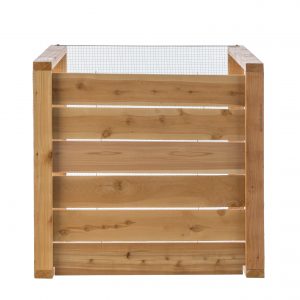
Making compost is as simple as tossing organic waste into a bin and waiting for it to decompose, right? Not quite. To create high-quality compost in the minimum amount of time, you need five key ingredients. Before we discuss those ingredients, let’s take a closer look at the decomposition process.
The science of composting
Microorganisms (bacteria and fungi) in your compost bin chemically decompose organic waste into humus. As bacteria breaks down organic matter, they produce heat, acids and carbon dioxide. This heats up the compost pile, which causes a different breed of heat-loving bacteria to take over. They speed up the decomposition process and finish the job.
These various aerobic bacteria are the most plentiful and effective decomposers in your compost bin. So it’s important to create the right conditions for them to do their work. To turn waste into humus as fast as possible, these bacteria need five things:
- Green matter (nitrogen)
- Brown matter (carbon)
- Oxygen
- Moisture
- Warmth
Examples with green matter (nitrogen):
- Grass clippings, green leaves, weeds, flowers
- Fruit and vegetable scraps, like apple cores, orange peels, etc.
- Stale or moldy bread
- Coffee grounds
- Eggshells
Examples with brown matter (carbon):
- Autumn leaves
- Woody plant stalks
- Corn cobs
- Nut shells
- Sawdust
How much of each ingredient do you need?
 Green (nitrogen) and brown (carbon) matter. Stick to a ratio of roughly 2 parts brown to 1 part green. You can easily maintain that balance with a variety of kitchen waste.
Green (nitrogen) and brown (carbon) matter. Stick to a ratio of roughly 2 parts brown to 1 part green. You can easily maintain that balance with a variety of kitchen waste.- Moisture: Keep your pile damp, but not soaked. If a heavy rainstorm drenches your pile, the chemistry might temporarily be off and decomposition may slow. But your cedar composter is designed to drain off excess water quickly and restore moisture balance. If your composter gets a lot of sun or there’s a heat spell, your pile might dry out and need water. Simply hose it down until it’s thoroughly damp.
- Oxygen: The open design of Steve’s Earth Engine cedar composters helps to ensure proper airflow around your pile. Install your bin at least two feet away from walls and fences for good airflow. To aerate the middle of the pile, turn the top 18 inches with a pitchfork or spade every 2 – 4 weeks. A well-aerated pile smells earthy and slightly sweet. A poorly aerated pile smells sour and rotten. If your pile stinks, that means that anaerobic (airless) decomposition is happening, which produces smelly gases. It’s time to turn the pile and let it breathe!
- Warmth: The workhorses of your compost bin—the aerobic bacteria—need the pile to be above freezing temps in order to begin doing their job. But bacteria will work best in warmer weather—55 degrees and above. If you live in a climate with cold winters, your pile will likely go dormant during this time. You can continue to add organic waste all winter, and decomposition will restart in the spring.
Add your greens and browns in layers
For the fastest, most successful decomposition of your organic waste, it’s important to add the waste in layers. Alternate between brown and green, while still maintaining a 2-to-1 ratio of brown to green. Some of your waste will be a mix of green and brown—like a bucket of food scraps. That’s fine. The ratio doesn’t need to be exact—just try to stay within range.
You can either add all the layers at once and let it cook, or add layers over time. There are many different composting methods. Choose the one that works best for you.

How long until I have garden-ready compost?
The time it takes to create humus depends on your compostconditions—warmth, moisture, air and your ratio of greens and browns. If conditions are ideal, expect to have finished humus in about four weeks If conditions aren’t optimal, the process will take longer— two months or more.


 Green (nitrogen) and brown (carbon) matter. Stick to a ratio of roughly 2 parts brown to 1 part green. You can easily maintain that balance with a variety of kitchen waste.
Green (nitrogen) and brown (carbon) matter. Stick to a ratio of roughly 2 parts brown to 1 part green. You can easily maintain that balance with a variety of kitchen waste.




